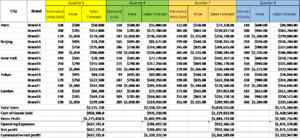Market Place Simulation – Marketing Strategies Evaluation
Objectives, Marketing, Decisions, and Strategies for the Team’s Brand
The marketing strategies for our team’s three brands are evaluated based on objectives, marketing decisions, and strategies adopted. The pricing objective will ensure that all three brands are priced competitively. Objective advertising will ensure the product can reach a wider market audience, and the objective of selling will entail achieving more profits. Notably, a marketing decision will be taken regarding the pricing of the three brands. Prices will remain the same across quarters 4 and 5 as the major focus will be on the number of units sold for each brand. Therefore, the market decision for advertising will entail increasing the number of units for the three brands. Essentially, this will involve using a multi-channel approach to advertise the brands in selected markets. Selling the brands to the chosen markets will be based on a decision that all markets should be targeted with similar products but bearing different prices. The strategy for pricing will include conducting a market survey and comparing prices with those of competitors. The strategy for advertising will entail putting more effort into channels that draw more sales, and for selling, a strategy of increasing units for the brand with the highest demand for every market will be adopted.
Do you need help with your assignment ? Get in touch with us.
Product Position for the Brands
Brand A
Brand A is the product in question when the 4Ps marketing mix is considered. The price of brand A will be $500, $495, $505, $495, and $510 for Paris, Beijing, New York, Tokyo, and London, respectively. The price difference is due to preferences in those regional markets. Further, the prices align well with the competitive practices of other sellers. Notably, the cities pointed out represent the place element of the marketing mix for both Brand A and all three brands. The promotion element will entail multi-channel advertising in the five markets.
Brand B
Brand B is the second product with prices of $785, $750, $790, $750, and $750 for Paris, Beijing, New York, Tokyo, and London, respectively. The markets with the same price are due to buyers bearing the same characteristics in taste and preference. The promotion element for brand B will entail social media marketing of the product.
Brand C
The product element of the third brand is Brand C. Its price element will entail $1,050, $1,030, $1,060, $1,040, and $1,050 for Paris, Beijing, New York, Tokyo, and London markets, respectively. The promotion aspect of Brand C will entail a multi-channel advertisement plan that will include social media marketing, newspaper advertising, and influencer marketing.
Recommended Comprehensive Marketing Strategies
The marketing strategy for Brand A will entail a multi-channel advertising strategy. The prices of the brand will be communicated in the advertisement and attracted consumers will place their orders. For Brand B, social media marketing will be adopted. Notably, this will entail creating social media sites for the product upon which orders for the product will be received at the quoted prices. Lastly, Brand C will be sold through a multi-channel approach. However, social media influencers will be relied upon more than others, with most of them being contacted to promote the product. A commission will be paid to them on all orders received through them.
Importance of Brand Equity and Brand Management
Brand equity is crucial as it represents a brand’s value, reputation, and recognition in the market. Strong brand equity fosters customer loyalty, competitive advantage, and higher profitability. Each of the three brands will require effective brand management. Effective brand management ensures consistent messaging, positive associations, and emotional connections, enhancing long-term success and resilience against market challenges in quarters 5 to 8.
Pro Forma Profit and Loss Statement
References
Saini, A. (2022). Mapping 4Ps Of Marketing with Business Intelligence: The Way to The Future of Marketing. Central European Management Journal, 30(3), 167-173.
ORDER A PLAGIARISM-FREE PAPER HERE
We’ll write everything from scratch
Question
The purpose of this assignment is to evaluate current marketing strategies to determine a marketing mix that drive sales and maximize long-term profits.

Market Place Simulation – Marketing Strategies Evaluation
In a 500-750-word individual paper, evaluate the marketing strategies currently in place and address the following:
Report objectives, marketing decisions, and strategies for your team’s brands, pricing, advertising, and selling based on what has been completed in the simulation through Quarter 4.
Define specific product positioning for all brands and explain why the positioning appeals to selected target markets. Be sure to include requirements for effective market segmentation alignment appropriate to the product, utilizing the 4 Ps of the marketing mix.
Recommend comprehensive marketing strategies for each brand, including pricing, advertising, and selling strategies. Justify the recommendation based on the sales, profits, and long-term profitability of the product within the simulation.
Evaluate the importance of brand equity and brand management for the team’s success in Quarters 5-8.
Show specific prices for each brand and estimate demand (number of units sold) for each quarter. Use the prices and demand estimates to forecast sales for each quarter. Display the resulting data on a pro forma profit and loss statement for Quarters 5-8.
Estimate costs for every category and display the resulting data on a pro forma profit and loss statement for Quarters 5-8. Project financial outcomes (gross profit, operating profit, net profit, and cumulative net profit) for Quarters 5-8 and display the results on a pro forma profit and loss statement for each quarter.



